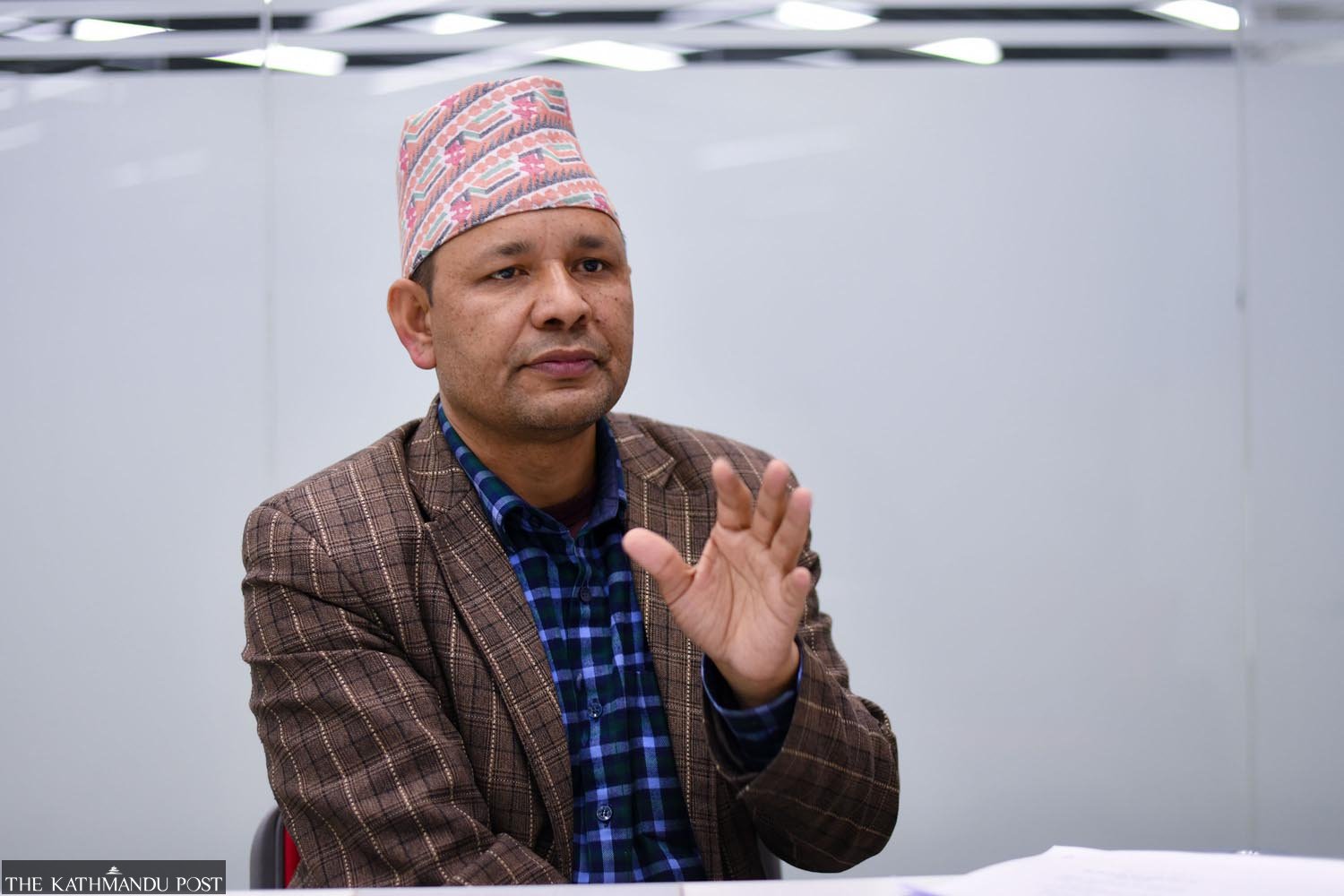The KP Sharma Oli government is struggling to endorse ordinances it recently introduced. Of the six ordinances it brought, the ordinance on land has been widely criticised. The Post’s Thira Lal Bhusal sat down with land rights activist Jagat Deuja, who is also the executive director at the Community Self Reliance Centre, an NGO, to talk about the controversial land ordinance and overall land rights issue in the country.
Why did Oli’s land-related ordinance court controversy?
It drew controversy mainly because it was introduced through ordinance. Otherwise, based on the content, it should not have been so controversial. The ordinance aims to address some practical problems in implementing the provisions included in previous legal amendments. The issue of providing land to the landless Dalits, landless squatters and unmanaged settlers has remained unresolved for decades.
Several initiatives taken by various governments since the 1990 in this regard haven’t succeeded due to lack of proper legal provisions. In the past, different governments formed different commissions and distributed lands based on Cabinet decisions. This was challenged in the court and the Supreme Court ordered the government to distribute land only after formulating a law for the purpose.
Then, the government made the eighth amendment to the Land Act in 2020. The amendment for the first time categorically stated that the landless Dalits, landless squatters and unmanaged settlers would be given land. Also, the amendment defined landless and unmanaged settlers. It said the landless squatters will be given land for one time if they are staying in a place, which is not covered by trees and bushes, for 10 years (as of 22 February, 2020, when the amendment came into force).
There is also a clause that defines the areas that can’t be distributed–for instance, land covered by trees; land with religious and cultural importance; the land which local governments need; the area under national parks and reserves. In sum, the amended Act said that if an area, despite being described as forest area in the record, has been used for 10 years, it can be given to landless for free while the unmanaged settlers can get it by paying for it.
How much land can they get, when distributed?
For the purpose of residence, the landless can get up to 130 square metres in urban areas and 340 square metres in other areas. For agricultural purposes, they can get up to 2,000 square metres in the Tarai and 3,000 square metres in the hills and mountains. This is how the ceilings have been fixed for distribution purposes. But there were problems while implementing the law. Representatives from forest department in district committees said they can’t allow use of forest area based on the Land Act as the Forest Act doesn’t allow them to do so. Thus the process was in a stalemate. The latest ordinance aimed to break that deadlock.
How do you find and determine the areas for distribution?
The eighth amendment of the Land Act stated that the places stated as forest areas in records where there are markets, farms or cultivation for the past 10 years (as of February 2020) can be distributed to the landless squatters. For instance, Bhalubang of Dang district is stated as a forest area but there is a big market there. There are many such areas in the country. This ordinance asks to first conduct a survey of such areas, convert them to government land and then distribute them to the landless people. It is against distributing any forest land without first converting it into government land.
Were there more specific reasons the ordinance courted controversy?
The ordinance added certain categories of land that can be distributed. It adds the places that are stated in the record such as pasturage, market, hatbazar (fete areas) can be distributed. But this was based on the provision of the Act that asks for an update of records based on the reality in the field, and to distribute the lands as per the aforementioned process. Such land can be distributed only after the executive committee of the local government approves it.
But can’t this provision be misused by local representatives? There are many cases of central and local politicians making decisions to benefit those close to them?
There would be such a possibility if a mayor or a ward chair alone can take decisions. But this decision should be taken by a meeting of the executive committee of a local unit. How can the body jointly make a wrong decision?
But we have many instances when rival politicians forge consensus and make decisions by completing formalities.
I don’t see such chances because there are clear provisions. For instance, a person must have stayed in such a place for the past 15 years as of now. Second, the latest technologies help us check such things immediately.
What are other changes this ordinance made?
The earlier Act had given eight bases to categorise the land. Categorisation based on eight bases was scientific but it couldn’t be practically implemented. Now, the ordinance has given only three criteria–nature of the land, area and valuation–for categorisation. This is practical. In essence, the ordinance has elaborated certain things to address the practical problems faced in the course of implementation.
Two changes it has made in the Forest Act and National Parks Act are significant. Earlier, the ownership of a forest area could be transferred only through a Cabinet decision. The ordinance now has said the landless Dalits, landless squatters and unmanaged settlers staying in such places for 15 years can be given land. Second, it has also given a solution to those who are staying in the unrecorded land in the buffer zone of a national park. It wouldn’t have drawn such controversy had it not been bundled together with a provision related to the ceiling for real estate business and had it been introduced through a regular bill.
What are the provisions in this ordinance related to the real estate business?
The existing Act gives a waiver in the land ownership ceiling for business purposes. But it doesn’t say they can also sell it. It didn’t affect those who used land for purposes such as tea estates. The real estate companies were not allowed to sell the land as the existing Act mentioned only the waiver in the land ownership ceiling. The new ordinance allows selling of the land above the ceiling after developing it as plots or making houses on it if that is in a residential area.
Some people have obtained land through ceiling waiver stating certain purposes but later using it for other purposes. Also, attempts to swap the land have emerged as a challenge. Don’t you see chances of misusing the ceiling waiver provision?
I don’t see the chances of misuse because the Act and regulations have very clear provisions. If someone wants to swap, the new land must be of the same area, provide the same quantity of production and ensure the same number of jobs. On top of that, the Supreme Court recently ordered the government that the land to be swapped should have equal valuation.
What is the number of landless Dalits and squatters?
The total number of landless people is 300,000 (100,000 dalits and 200,000 squatters). Thirty years ago, the number of landless people was 500,000. Later, some went abroad for jobs or got engaged in other income generating activities and they bought land. Now the number of unmanaged settlers has again increased to nearly 800,000. But the landless Dalits and squatters are the ones who should be given priority while distributing land.
Of the 300,000 landless people, around 80 percent can stay at the same place where they have been staying for many years. They only need a certificate for the land they have been cultivating for decades. Nearly 15-20 percent of them need to be shifted as they are either staying within the right of way of a road or on a riverbank. So, this shouldn’t be a big deal if done properly.
The ordinance says, the state provides land to the landless once and for all. Land distribution should be viewed from the perspective of our constitution, which has guaranteed the rights of residence for every citizen. The Article 40(5) of the statute has said, “The state shall once provide land to the landless Dalits in accordance with law.” So this is the state’s constitutional obligation.
Don’t you think that approach may encourage people to occupy public land and capture it over time?
So far, we adopted the approach of distributing unregistered land. If we need to protect public land, then we have to adopt the policy of confiscating the land beyond the ceiling and distributing that to the landless. With this approach, we can protect public land while also reducing the economic discrepancy between the haves and have nots.
Can the government differentiate genuine landless and those who want to occupy public land posing as squatters?
Identification was a problem before the Land Act was amended in 2020. Now the government can identify them accurately. The government has developed an advanced system. Of the 753 local units, around 612 units have collected data. In each local unit, there is a dedicated team to work on this. The trained staff collect data and verify them through elected representatives and staff at the respective ward office.
Also, representatives of political parties and other stakeholders are involved in the process. The data is included in an integrated software only after that. It is endorsed by the executive committee of a local unit only after making it public through a notice. So, there is less chance of fake people acquiring public land. In the first place, they have to show evidence that they have been staying there for the past 15 years.
How do the authorities verify whether a person staying in a squatter settlement has land in other places?
The records of all the land revenue offices across the country have been integrated into the central database system. So, if a person has a piece of land in his/her name in any part of the country, it is shown in the system. Any individual’s name recommended by a local unit recommended as landless can be cross-checked over whether he/she has a piece of land in any other part of the country. It also checks the land under the names of three generations—in the name of the same person, their parents and their children.







